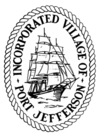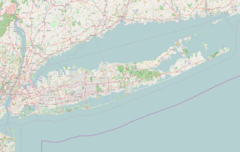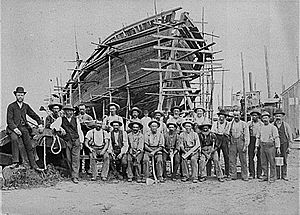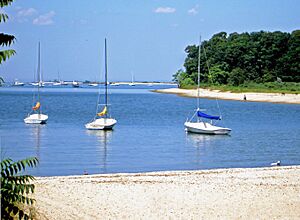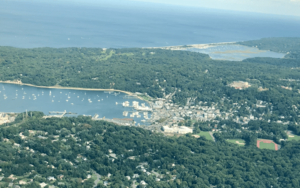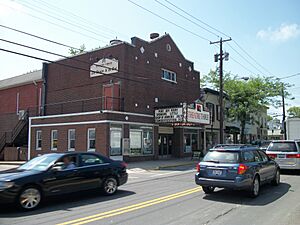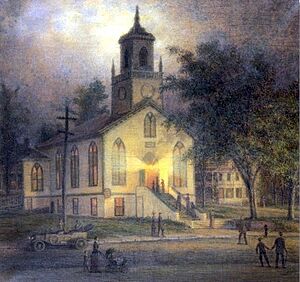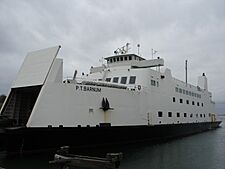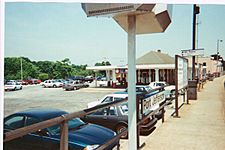Port Jefferson, New York facts for kids
Quick facts for kids
Port Jefferson, New York
|
||
|---|---|---|
| Incorporated Village of Port Jefferson | ||
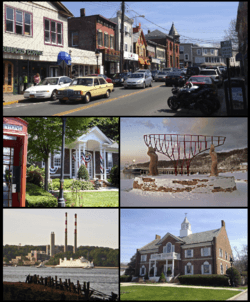
Clockwise from top: a view of shops on Main Street, monument commemorating the village's maritime past, Port Jefferson Village Hall, A ferry passes a local power plant en route to Bridgeport, Connecticut, Port Jefferson Free Library
|
||
|
||
| Nickname(s):
Port Jeff
|
||
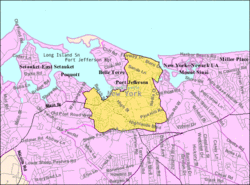
U.S. Census Map
|
||
| Country | ||
| State | ||
| County | Suffolk | |
| Government | ||
| • Type | Mayor-Council | |
| Area | ||
| • Total | 3.09 sq mi (8.00 km2) | |
| • Land | 3.06 sq mi (7.93 km2) | |
| • Water | 0.03 sq mi (0.07 km2) | |
| Elevation | 12 ft (4 m) | |
| Population
(2020)
|
||
| • Total | 7,962 | |
| • Density | 2,599.41/sq mi (1,003.55/km2) | |
| Time zone | UTC−05:00 (Eastern Time Zone) | |
| • Summer (DST) | UTC−04:00 | |
| ZIP Code |
11777
|
|
| Area code(s) | 631 and 934 | |
| FIPS code | 36-59355 | |
| GNIS feature ID | 0960968 | |
Port Jefferson, also called Port Jeff, is a small village in Suffolk County, New York. It is located on the North Shore of Long Island. In 2020, about 7,962 people lived there.
Port Jefferson was first settled in the 1600s. It started as a quiet farming area. Later, in the mid-1800s, it became a busy place for building ships. Today, Port Jefferson is a popular spot for tourists. It still has an active port with a ferry that goes to Bridgeport, Connecticut. It is also the end of the Long Island Rail Road's Port Jefferson Branch. The village is a main center for nearby areas like Port Jefferson Station and Mount Sinai.
Contents
Village History
Early Days and First Settlers
The land where Port Jefferson is now was bought from the Setalcott Indians in 1655. This was done by the first settlers of the Town of Brookhaven. The area was originally called Sowaysset. This Native American name meant "place of small pines" or "where water opens."
The first known house was built in the early 1660s by Captain John Scott. The first settler in what is now downtown Port Jefferson was John Roe. He was an Irish shoemaker who built his home in 1682. This house is still standing today. For many years, the community was very small, with only about five homes. In 1682, it was renamed "Drowned Meadow."
Some local stories say that the pirate Captain Kidd visited the harbor. Another legend says that John Paul Jones had a ship fitted here during the Revolutionary War. However, there is no real proof for these stories.
Shipbuilding and Growth
In 1797, the first shipyard was built in the town. By 1825, many shipbuilding companies were here. This brought more people and businesses to the area.
During the War of 1812, British ships caused problems for local shipping. To protect the area, a small fort was built on the west side of Port Jefferson Harbor.
In 1836, the community decided to change its name from "Drowned Meadow" to "Port Jefferson." This was done to honor Thomas Jefferson. They also built a causeway to raise the harborfront land. This helped turn the "swampish hamlet" into a busy port town.
Many shipyards grew along Port Jefferson's harbor. The village became the biggest shipbuilding center in Suffolk County. They built large ships, including those used for whaling. Many old homes from this time belonged to shipbuilders and captains. The Mather House Museum is one of these homes. It now serves as a museum about the village's history.
P. T. Barnum, the famous circus owner, once owned land in Port Jefferson. He wanted to make it the home base for his circus. But the people living there did not agree with his plans. He eventually sold his land. Barnum Avenue now runs through the area he once owned.
The area known as Hotel Square became a popular spot for tourists in the mid-1800s. It had many hotels and restaurants. The John Roe house was even turned into the Townsend House hotel. The village's first post office opened here in 1855.
In 1923, the Bayles Shipyard was sold to the Standard Oil Company. This ended Port Jefferson's shipbuilding industry. Many hotels closed as tourism went down. The harbor then became a place for oil and gravel businesses. Since the 1940s, it has also been home to a power plant. During the Prohibition era, the harbor was also used for rum-running. Years later, Port Jefferson's economy got better, with tourism becoming its main focus.
Modern Port Jefferson
The village of Port Jefferson officially became an incorporated village in 1963. After this, the lower part of Port Jefferson was improved. Tourism brought more money to the village. For example, in 1976, the old Mather & Jones Shipyard became Chandler Square. This is a promenade with many shops.
New public areas were created along the waterfront. The Danfords Hotel and Marina was a big project. It turned old and new buildings into a fancy hotel with a marina. This showed how the harbor changed from industrial use to a place for fun.
Harborfront Park was finished in 2004. It turned an old shipyard into a public park. The park has picnic areas, an ice skating rink in winter, and a walking path. An old shipyard warehouse was also rebuilt into the Port Jefferson Village Center. This is a new public space for events and activities.
Many historic buildings are part of the Port Jefferson Village Historic District. This district was added to the National Register of Historic Places in 2005.
Geography and Areas
Port Jefferson has two main business areas. They are about one mile apart along Main Street. These are called Lower Port Jefferson and Upper Port Jefferson. Lower Port Jefferson is near the water and is a center for tourism. Upper Port Jefferson is near the train station.
Away from Main Street, Port Jefferson has several neighborhoods. These neighborhoods are built on hills. Harbor Hills is in the northeast part of the village. It is on the western edge of Mount Sinai Harbor. It also has the Port Jefferson Country Club. Brick Hill is west of Lower Port Jefferson. It was first developed by P. T. Barnum. West of Upper Port Jefferson is Cedar Hill. This area has the Cedar Hill Cemetery, built around 1859. People used to go there to see views of the village.
Port Jefferson Harbor is a natural deepwater harbor. Setauket Harbor branches off to the west. The Cove is a small area of water that was dug out in the early 1900s. It was originally called Seaboard Hole. Its name was changed to attract tourists. You can also find large sand dunes here that were created when the cove was dug.
Population Information
| Historical population | |||
|---|---|---|---|
| Census | Pop. | %± | |
| 1880 | 1,724 | — | |
| 1890 | 2,026 | 17.5% | |
| 1970 | 5,515 | — | |
| 1980 | 6,731 | 22.0% | |
| 1990 | 7,455 | 10.8% | |
| 2000 | 7,837 | 5.1% | |
| 2010 | 7,750 | −1.1% | |
| 2020 | 7,962 | 2.7% | |
| U.S. Decennial Census | |||
In 2010, about 7,750 people lived in Port Jefferson. The village had about 2,500 people per square mile. Most of the people living in the village were White (88.5%). About 10.5% were Hispanic or Latino. Other groups included Asian (2.1%) and African American (1.6%).
The average age of people in Port Jefferson in 2010 was 43.6 years old.
Arts and Culture
Port Jefferson is home to Theatre Three. This is a non-profit theater company that started in 1969. Each year, Theatre Three puts on several musicals and plays. They also perform "A Christmas Carol" during the annual Dickens Festival. Theatre Three is in Athena Hall, a building from 1874.
Two famous landscape painters lived in the village in the late 1800s. They were William Moore Davis and Leon Foster Jones. Both artists painted many scenes of Port Jefferson and its harbor.
Yearly Events
Port Jefferson hosts the annual Port Jefferson Village Dickens Festival every December. This festival celebrates the books and times of English writer Charles Dickens. People dress in 19th-century clothes. There are house tours, caroling, and booths from local businesses. Students from Port Jefferson schools also share their poetry and art.
Many small festivals happen during the summer. These often feature music and crafts. Every Fourth of July, there is a big parade on Main Street. The village also has outdoor concerts and movie nights in Harborfront Park during July and August. Port Jefferson also hosts a boat race series called the Village Cup Regatta. Money raised from this event helps cancer research.
Education
The Port Jefferson Union Free School District serves Belle Terre and most of Port Jefferson. In 2008, about 1375 students were in the district.
There are three schools in the district:
- Edna Louise Spear Elementary School (Pre-K to 5th grade)
- Port Jefferson Middle School (6th to 8th grade)
- Earl L. Vandermeulen High School (9th to 12th grade)
The Middle School and High School share the same building. An older middle school building now houses the Jefferson Academic Center. This is a vocational school run by Eastern Suffolk BOCES.
Media
- 93.3 The Breeze is a radio station that serves Port Jefferson.
- Newsday is a daily newspaper.
- The Port Times Record is a weekly newspaper.
Transportation
Port Jefferson has a major ferry route, a train station, bus lines, and many roads.
The Bridgeport & Port Jefferson Ferry connects Long Island to New England. This is one of only two ferry routes between Long Island and Connecticut. The ferry company started in 1883. P. T. Barnum, the circus owner, helped start the company. He owned land in both Port Jefferson and Bridgeport, Connecticut. He became the company's first president.
The village is also the end point for the Long Island Rail Road's Port Jefferson Branch. This train line connects to the main train line at Huntington station. From there, you can go to Pennsylvania Station in Manhattan or Atlantic Terminal in Brooklyn. A train ride from Port Jefferson to Manhattan usually takes about 2 hours. Train service first came to Port Jefferson in 1873. The ferry terminal and train station are about one mile apart. There have been talks about creating a shuttle to connect them.
Suffolk County Transit runs bus routes in Port Jefferson. Bus route 51 goes from Patchogue station to Port Jefferson station. It stops at places like Ronkonkoma station and Stony Brook University. It runs every 30 minutes on weekdays.
Port Jefferson's Main Street is part of New York State Route 25A. This is a scenic and historic road along Long Island's North Shore. New York State Route 347 is a multi-lane highway that starts southeast of the village. New York State Route 112 is an important north-south road that starts just south of the village.
Notable People
Many interesting people were born or lived in Port Jefferson:
- Jesse Ball (born 1978), a novelist and poet.
- Walter Berndt (1899–1979), a cartoonist known for his comic strip Smitty.
- John Buscema (1927–2002), a famous comic book artist.
- Ted Chiang (born 1967), a science fiction writer.
- Dom Famularo (1953–2023), a drummer, author, and speaker.
- Chris Ferraro (born 1973) and Peter Ferraro (born 1973), former NHL hockey players.
- Dan Gurney, an American race car driver.
- Alan North, an actor.
- Elijah Riley (born 1998), an NFL Safety.
- Austin Roe (1748–1830), an American spy during the Revolutionary War.
- Bob Samuelson (born 1966), an Olympic medalist in volleyball.
- Tom Veryzer (1953–2014), an MLB shortstop.
- Louis Zukofsky, an American poet.
Images for kids
Error: no page names specified (help). In Spanish: Port Jefferson (Nueva York) para niños
In Spanish: Port Jefferson (Nueva York) para niños


